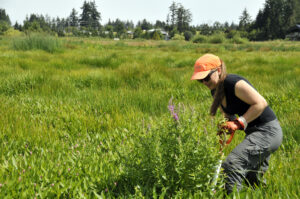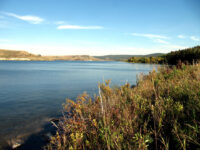People urged to help curb spread of invasive plant species
By Lethbridge Herald on May 22, 2020.
 Nature Conservancy of Canada photo - A volunteer removes purple loosestrife in Maber Flats, British Columbia.
Nature Conservancy of Canada photo - A volunteer removes purple loosestrife in Maber Flats, British Columbia. Greg Bobinec
Lethbridge Herald
gbobinec@lethbridgeherald.com
As many Canadians are itching to get back outdoors after weeks of self-isolation and a lengthy winter, some are able to in provinces where restrictions have been lifted, while others remain close to home.
The Nature Conservancy of Canada (NCC) and Canadian Council on Invasive Species is marking Invasive Species Awareness Week by urging people to help minimize the spread of invasive species, whether they are resuming recreational activities or spending time in their yard. NCC senior conservation biologist, Dan Kraus, suggests that with more people spending time at home and taking short walks in local parks, now is an ideal time to identify and report invasive plants in their community.
“Globally, invasive species have been identified as the number two threat to nature, with habitat loss being the primary issue,” says Kraus. “Invasive species not only threaten our Canadian plants and animals, but also impact our economy and well-being. For example, Japanese knotweed and European invasive species cost us billions of dollars each year and are altering the character and functions of many Canadian ecosystems.”
Spring is an ideal time to audit your backyard of invasive species. While many non-native plants are not an issue for biodiversity, there are several that are known to spread from backyards into nearby natural areas. Property owners can play an important role in reducing the spread of these species by removing them from their gardens.
“Like COVID-19, invasive species are spread by the everyday things we participate in,” says Barry Gibbs, executive director of the Canadian Council on Invasive Species. “As we have seen, by making changes in our behaviour, we can have a major impact on the spread. Many invasive plants have been unintentionally introduced by gardeners and you can change that. Check to make sure you are not planting invasive species you see on your property and report any invasive species you see away from your property. Each of us can take action and make a difference.”
Five plants that Albertans should be aware of when looking through their gardens or walking through natural areas include the yellow flag iris, the common tansy, purple loosestrife, leafy spurge and the common toadflax. Many invasive species have few natural predators to control them, and once they get into ecosystems, they’re often able to rapidly spread and can negatively impact our native plants and animals.
People can help by reporting sightings which contributes to early detection. Canadians of all ages and levels of experience can join in the effort to stem the spread of invasive species by downloading the iNaturalist phone app (iNaturalist.ca) and uploading photos to help scientists and government agencies identify the species and monitor their spread. A list of invasive species that could be in your backyard or community can be found at natureconservancy.ca.
Follow @GBobinecHerald on Twitter
-1




